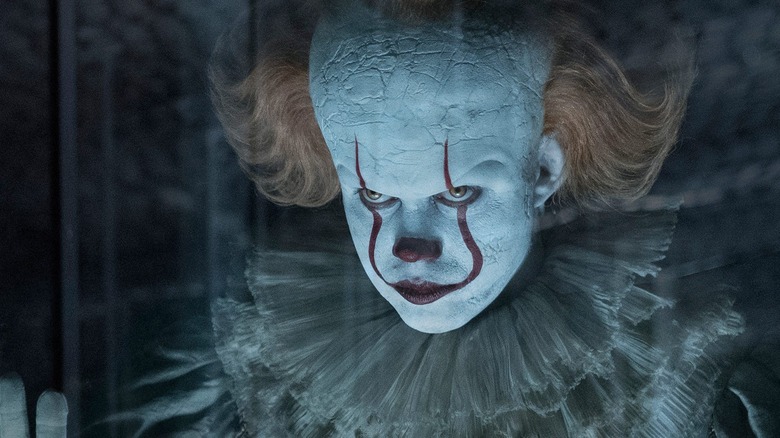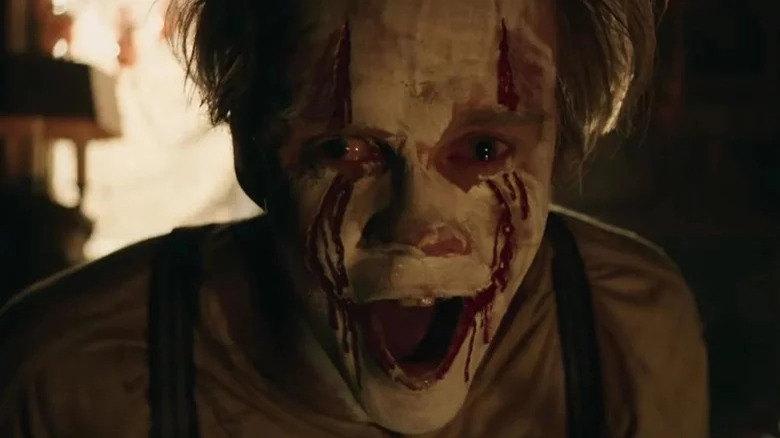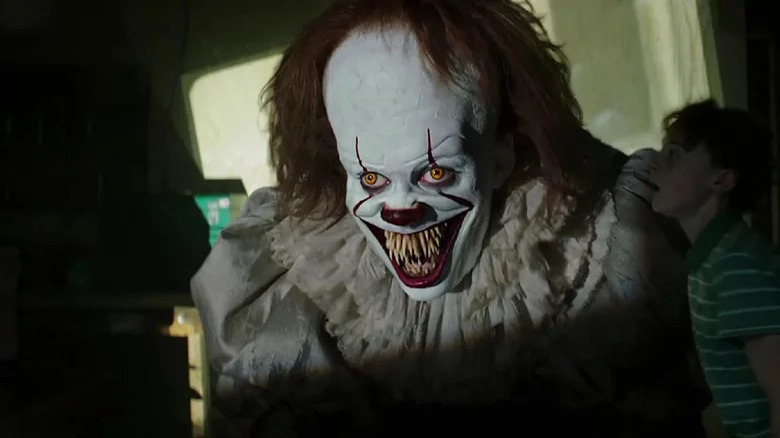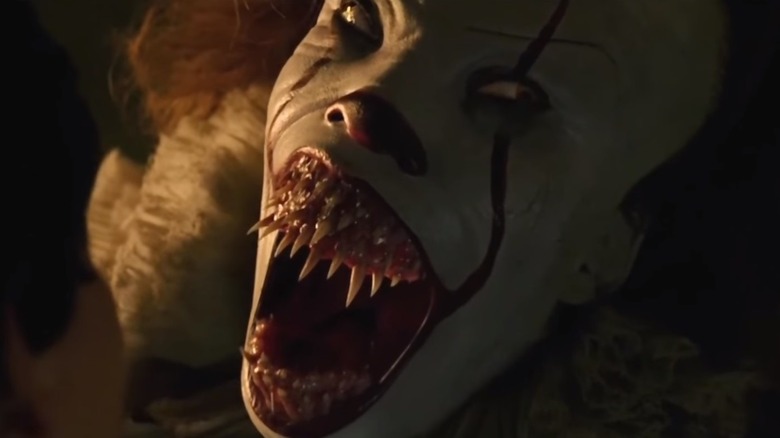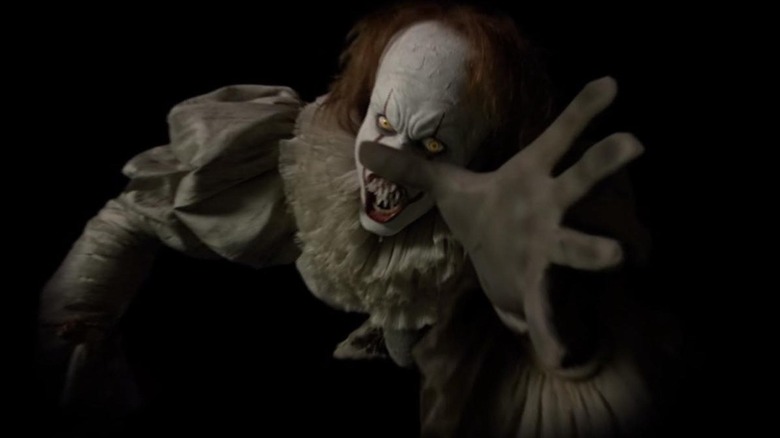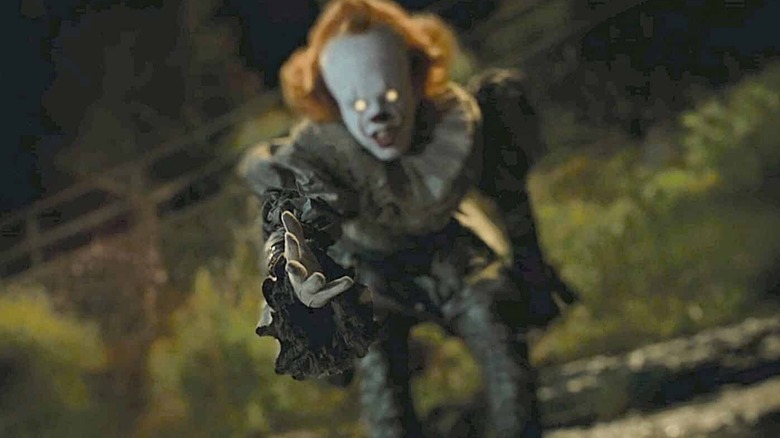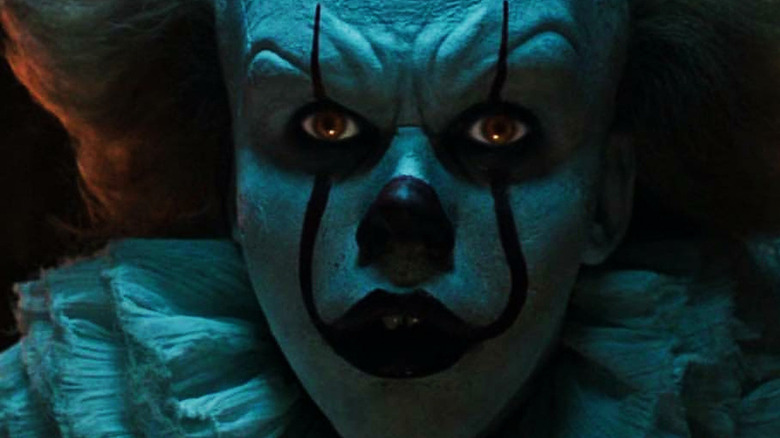It: Chapter 3 - Is It Happening?
The first thing that must be acknowledged about Stephen King's 1986 novel "It" is that it is over 1,100 pages long. The novel — about a group of seven friends who are stalked by a demonic, shape-shifting clown that lives in the sewers under their small Maine hometown — spans two time periods: Half of the book takes place in the 1950s, when the protagonists were hovering around age 12, and half takes place in the present day, when the protagonists had grown into unhappy adults, still haunted by memories of their childhood nemesis. The book alternates between these two time frames, showing how confronting a demon — and your deepest fears — as a child can lead to trauma and dysfunction as an adult. Ultimately, the clown must be faced again in the 1980s.
The mythology of "It" is complex and baffling. Although it's not covered in the movies and the TV miniseries adaptations, the novel explains that the evil shapeshifting clown Pennywise is, in fact, an ancient, eldritch spider demon from another dimension that "surrounds" known space. Pennywise came to Earth centuries ago and has been regularly stalking the humans of Derry, Maine, ever since. Every 27 years, Pennywise awakens from its hibernation cycle to feed on human meat. It learned long ago that human beings are tastier when in a state of abject fear, and, as such, learned to read people's thoughts and take the form of whatever they feared most. In order to gaze at the monster's true form, one must engage in the Ritual of Chüd.
Now that we're all on the same page, let's take a look at the TV and film adaptations.
It on TV
One other thing: It's not mentioned much in the movies or TV shows, but Pennywise also has an arch-nemesis in the form of a giant galactic turtle named Maturin, the same one from many of Earth's ancient creation myths. This turtle vomited up the universe when it had a stomach ache. Pennywise the clown Cthulhu hates the Ancient Giant Space Turtle God. It's all perfectly clear and logical.
In 1990, Tommy Lee Wallace wrote and directed a miniseries adaptation of "It," breaking it into two movie-length chapters, one set in the '50s with a child cast, and one set in the present day. The clown was played by Tim Curry, who left a nightmarish residue in the minds of all the children who saw him. In an attempt to match the length and density of the novel, the miniseries runs about 192 minutes.
Not talked about as much, at least in North America, is the 1997 TV series "Woh," a 52-episode epic produced in India by Zee TV. That series starred Indian superstar Lilliput as the evil clown and transposed the central action from Derry, Maine to the Indian city of Panchgani. "Woh" may be the longest filmed rendition of "It" ever produced, running about 18 and a half hours. It also changed — and arguably improved — the ending of King's original novel, which is popularly known to be pretty weak. In "Woh," it's revealed that Pennywise is not an ineffable space deity, but the ghost of a human being killed years before. Prior to becoming a murderous ghost, Pennywise was a victim of bullying. Rather than confront the monster in the sewers of Maine, Pennywise's victims in "Woh" absolve him and he moves on to the other side.
It in theaters
Fast-forward to 2017, and director Andy Muschietti — working from a screenplay by Chase Palmer, Gary Fukunaga, and Gary Dauberman — adapted "It" for a third time, this time as a pair of feature films.
Bifurcated like the 1990 miniseries, the first "It" from took place in the past with the protagonists as children, only now time-shifted forward to the late 1980s. "It Chapter Two," written by just Dauberman, was released in 2019, and took place in the present day with a new cast of adults. Not to be outdone, however, "It Chapter Two" also included extended flashbacks with the same young actors from the first chapter. In toto, the two "It" feature films added up to 304 minutes.
While the story concluded at the end of "It Chapter Two," and the Clown Demon (played by Bill Skarsgård) was once again bested by the bravery and resourcefulness of the characters, there was still a lot left unexplored. The turtle god wasn't addressed, for one. Secondly, the kids from the 2017 film did a lot of their own research into the past of Pennywise, finding scary old photos and film reels wherein Pennywise first took the form of a clown. This implied a much broader backstory for Pennywise, likely rife with terrifying episodes of people being tormented and eaten over the course of Derry's dark history.
The "It" feature films had many fans, and some wondered if the unaddressed history of Pennywise would grace the big screen again. In 2019, director Andy Muschietti put the kibosh on such rumors, stating that "For now, there's nothing on the table" in terms of development for another project.
Since then, however, some things have changed.
It Chapter Three
Speaking to Gizmodo at the time of the second film's release, Muschietti did, however, indicate that there is potentially more story to be told in that universe:
"Mythology is something that always has opportunities to explore. It has been on Earth for millions of years. He's been in contact with humans for hundreds of years, every 27 years. So you can imagine the amount of material ... It's always exciting to think of eventually exploring this mythology. It's very exciting."
While nothing was in the works in 2019, there have since been new developments. Muschietti, it seems, has a new plan.
It was reported in Variety in April of 2022, that a prequel series called "Welcome to Derry" was in the early stages of development. The new series was to take place in the same timeline as Muschietti's films, only throwing the action back to the 1960s. As of this writing, that series has nearly come to fruition; production on "Welcome to Derry" began in May 2023. Muschietti is producing the series with his sister and producing partner Barbara, with Jason Fuchs writing. Muschietti will also direct its first episode. A tweet from the Max streaming service claimed "Welcome to Derry" will be released in 2024.
A prequel is a wise tack, as a direct sequel would make Pennywise's death less significant. It would also devalue the sacrifices made by several characters at the end of "It Chapter Two." By the original book's mythology, Pennywise had been stalking Derry, Maine for decades, so looking into the past for story ideas is perfectly logical.
Welcome to Derry
It seems this idea had been germinating for a while. In a 2019 interview, Pennywise actor Bill Skarsgård idly discussed how "It" could be revisited, but that it would have to be an extrapolation of King's work, given that he already thoroughly covered all of the novel's most notable events. He said:
"There is this interesting aspect of going back in time before all this happened. There might be a story there that might be worth exploring. Obviously that would be a story that's not in the book, it would be a freestanding story, but obviously within the same universe. So, there might be something interesting out of it. I think it would be fun."
"Welcome to Derry" wasn't greenlit until February of 2023, but it will be a prequel, just as the filmmakers discussed four years ago. So far, we know that the new series will star Jovan Adepo from "Watchmen" and "The Stand," as well as Chris Chalk from "Perry Mason," Taylour Page from the movie "Zola," Madeline Stowe, James Remar, and Stephen Rider. There is no word as to whether or not King will be involved in production at all. Given the number of films and TV shows based on the author's works, however, it's likely he'll step back and let Muschietti and Fuchs play in his sandbox.
Expanded universe stuff
Few other details about "Welcome to Derry" have yet been revealed, although Muschietti teased audiences by posting a photo from the set on his Instagram account. All that audiences might glean, however, is that Derry's sheriff is named Clint Bowers. If the name rings a bell, it's because it's the last name of Henry Bowers, the school bully from King's novel that tormented the septet of protagonists. Jarred Blanchard and Michael Cole played the character in the 1990 miniseries, while Nicholas Hamilton and Teach Grant played him in Muschietti's movies. Henry Bowers fell under the spell of Pennywise, and seemed to go on a murderous rage at the evil clown's distant bidding.
According to King's novel, Henry's deceased, abusive, alcoholic father was named Oscar "Butch" Bowers. A family member named Clint is not mentioned in King's novel or any of the other renditions of the story to date, meaning Muschietti invented him. Given the timeframe, one might assume that Clint is Butch's father. A big theme of "It" was the survival of abuse and the passing of trauma from one generation to the next. It remains to be seen if Clint will also be an abusive, alcoholic father.
It's also unclear if "Welcome to Derry" will tap into the vast pool of interconnected Stephen King mythology already at their fingertips. King was notorious for spreading supporting players across multiple novels, sometimes just in passing. For instance, the character of Ben Hanscom (Brandon Crane and John Ritter in 1990, Jeremy Ray Tyler and Jay Ryan in Muschietti's movies) is mentioned by name in King's 1994 novel "Insomnia" as well as in his 2011 novel "11/22/63."
The King-verse
Also appearing in "11/22/63" were the "It" characters of Beverly Marsh and Richie Tozier, albeit in only the smallest of roles. Eddie Kaspbrak and Stanley Uris are mentioned in the same story, as is Mike Hanlon. Hanlon is also talked about in King's 2001 novel "Dreamcatcher" and appears in "Insomnia."
It's worth noting that "Welcome to Derry" is set in the forward time-shifting of Muschietti's movies that are set in the late 1980s and the late 2010s. Setting a prequel in the 1960s lines up with that time shift. King's novel, meanwhile, began in the 1950s and the characters were adults by the 1980s.
As for Pennywise, there is a lot more to get into than the Lovecraftian shorthand listed at the top of this article. If one delves deep into Stephen King's lore, one will find an entire Theogony of evil gods that infiltrate many of the author's stories. Pennywise is only one of these gods and has interacted — in various forms — with multiple King stories, serving as an underhanded antagonist throughout. Pennywise is, in fact, a deity called a Glamour, a type of creature that appeared in "Four Past Midnight," 2018's "The Outsider," the short story "If It Bleeds," and the 2021 noir novel "Later."
Delving further into King lore, one finds that Pennywise was able to access an ineffable source of magic called the Deadlights. The Deadlights played an important function in King's notoriously complicated Dark Tower series, a seven-novel cycle written from 1982 to 2004 that, using interdimensional flapdoodle, essentially linked all of Stephen King's stories together. The Deadlights were accessed by a character known as the Crimson King, who serves as the supreme evil Satan-like figure of the Steven King-verse.
The Crimson King
The Crimson King — even more powerful than Pennywise and Maturin — appears throughout the "Dark Tower" book series, one of which was adapted into a poorly received feature film in 2017. "The Dark Tower" details the conflict between an immortal gunslinger named Roland Deschain (Idris Elba) and a wicked sorcerer named Walter Padick (Matthew McConaughey). Both are able to travel to Earth using high-tech interdimensional portals, and Walter has been reaching through these portals to abduct children with psychic powers, powers that he called "the shine."
And boom, just like that, "The Dark Tower" is linked to "The Shining" as well. If Walter amasses enough psychic energies from abducted children, he'll be able to topple the titular Dark Tower — an edifice in his home dimension, called Mid-World — and unleash a species of interdimensional monsters which it holds at bay. Pennywise may very well be a "junior" version of one of these monsters.
And to think, it all started with a simple fable of a clown — a symbol for childhood abuse — that lives in a sewer and eats children. Whether or not Muschietti intends to link "Welcome to Derry" to the vast fantasy universe of the Crimson King remains to be seen.
Resourceful King fans will also make note of other minor connections "It" has to other stories. Beverly Marsh, in passing, mentions the character of Frank Dodd, the serial killer from "The Dead Zone." Henry Bowers is given a mystical car by Pennywise (!) near the end of the novel, and it's a 1958 Plymouth Fury ... just like in "Christine." And in the alien invasion story "The Tommyknockers," a character mentions that they saw a sewer clown.
The King web, it seems, is vast.
